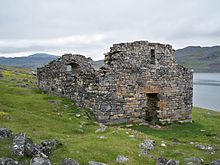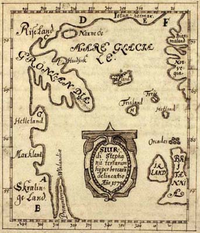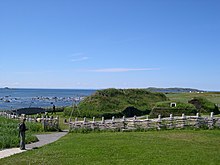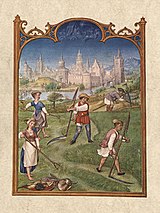中世紀溫暖時期
中世紀溫暖時期(Medieval Warm Period, MWP)是指北大西洋地區內由公元10世紀到13世紀所出現一個不正常溫暖的時期。
氣象記錄表明,不同地區的暖化峰值出現的時間不同,表明中世紀暖期不是全球統一的事件。[1]中世紀溫暖時期常常成為全球變暖的討論課題。有些人則稱呼為中世紀氣候異常(Medieval Climatic Anomaly)強調其他影響多於溫度。[2][3]
MWP之後,北大西洋與其他地區出現了區域性降溫期,常常稱作小冰期(Little Ice Age, LIA)。
MWP的可能成因包括太陽活動增加、火山活動減少、洋流變化等。[4]模擬證據表明,自然變化不足以解釋MWP,外部因素是必要的。[5]

研究
[編輯]中世紀溫暖時期的氣候十分不正常,當時正值歐洲的中世紀,大約在8世紀至13世紀[7]。歐洲已經進行大量關於中世紀溫暖時期及小冰期的初步研究,氣候不正常的現象已經是很明顯及有清晰的記錄。有研究者認為在一般認為的中世紀暖期前還有「早期中世紀暖期」(MWP-I),大約從5世紀持續到9世紀末。11至13世紀的則是「傳統中世紀暖期」(MWP-II)。[8]1965年,古氣候學先驅之一Hubert Lamb發表了基於植物學、歷史記錄、氣象學數據的研究,得到公元1200年和公元1600年前後英格蘭的平均氣溫與降雨。他認為:「各方面數據暗示,世界上很多地區都曾經歷過一個暖期,在11至12世紀左右、至少有上百年。之後的16、17世紀則是冷期,是末次冰期以來最冷的時期。」[9] 「中世紀暖期」和「小冰期」的說法很快流行開來亞洲地區影響最大大約是在公元950年至1150年,相當於中國的北宋時期(960年至1127年)。當初認為溫度的改變是全球性的。可是,這個觀點很快受到質疑,如IPCC第一次評估報告(1990)中稱「公元1000年前後的中世紀暖期(可能不是全球性事件)與19世紀中晚期才結束的小冰期……西歐、冰島和格陵蘭10世紀晚期至13世紀初(大約AD950–1250)的溫度異常地高。」[10]IPCC第三次評估報告(2001)概括了這項研究,指出「現在的證據沒法支持當時全球同步地發生不規則的冷暖轉變的論調,傳統所指的小冰期及中世紀溫暖時期只能有限地描述北半球或全球在過去幾個世紀中平均氣溫的改變。」[11] 全球的冰芯、樹木年輪、湖床沉積等氣象記錄表明,全球範圍內中世紀暖期可能比20世紀早中期略低0.03°C。[12][13]
古氣候學家重建特定地區過去幾個世紀的氣候時,通常將最冷的時期稱作「LIA」,將最暖的時期稱作「MWP」。[12][14]其他人則遵循這一慣例,當LIA或MWP時期內發生重大氣候事件,就將其與時期聯繫起來。因此,文獻中一部分「MWP事件」實際上是潮濕事件或寒冷事件,並非嚴格意義上的溫暖事件。特別是南極洲中部,那裡的氣候模式同北大西洋幾乎是相反的。
中世紀暖期的全球氣候
[編輯]MWP的性質與範圍(是否是全球性事件)一直有爭議。[15][16]2019年,PAGES-2k聯盟通過擴展的代用數據集證實[17],中世紀氣候異常不是全球同步事件:各個地區在MWP中最溫暖的51年不同時。他們主張對公元以來、工業化前的氣候變化進行區域性分析。[18]
發生事件
[編輯]北大西洋地區
[編輯]

Lloyd D. Keigwin (1996)對馬尾藻海洋底沉積物箱式取樣數據的碳14定年顯示,400年前(小冰期)與1700年前的海面溫度比現在低1 °C ;而1000年前(MWP)的海洋表面溫度比現在高1 °C 。[19] 波多黎各、墨西哥灣沿岸、佛羅里達到新英格蘭的大西洋沿岸的證據一致表明,北大西洋熱帶颶風活動在中世紀溫暖期達到一個高峰,隨後處於暫時的安靜期[20]。
中世紀溫暖時期,北極海域的浮冰大量減少,使古斯堪地納維亞人(或稱維京人)能橫越北大西洋,抵達格陵蘭和北美東岸,促成了與因紐特人的短暫相遇。
冰島
[編輯]冰島最早有人定居大約在865年到930年之間,當時人們認為冰島足夠溫暖,適合發展航海與畜牧。[21][22]Patterson et al.分析洋底沉積物與軟體動物生長模式,重建了羅馬溫暖期到MWP與小冰期的10年解析度尺度氧18、碳13同位素記錄。[23]Patterson et al.發現,在冰島有人定居後,夏季氣溫仍在高位,但冬季氣溫有所降低。[23]
格陵蘭
[編輯]
Mann et al. (2009)發現,格陵蘭島南部和北美洲部分地區在MWP(研究中定義為公元950–1250年)期間的溫度超過了1961–1990年水平,部分地區甚至超過1990–2010年水平。北半球大部在小冰期(研究中定義為15–17世紀)出現明顯降溫,但拉布拉多和美國個別地區的溫度似乎與1961–1990年水平大致相同。[7]MWP期間格陵蘭冬季氧同位素數據同北大西洋濤動(NAO)強相關。[24]

諾斯人殖民北美可能同暖期有關。[25]一般認為,諾斯人在暖期可以橫穿不封凍的洋面,殖民格陵蘭和臨近島嶼沿岸地區。[26]不過,哥倫比亞大學的一份研究表明,格陵蘭不是在較暖的時期被殖民的,格陵蘭的暖期只持續了很短時間。[27]公元1000年前後,足夠溫暖的氣候能支持維京人前往紐芬蘭島,建立臨時定居點。[28]

985年左右,維京人建立了格陵蘭東殖民地與格陵蘭西殖民地,都在格陵蘭島南端附近。他們在殖民初期放牧牛羊過活,並有約四分之一食物是海產。1250年之後,氣候變得更加惡劣,他們的飲食結構便向海產轉移。到1300年前後,鰭足類(海豹)占食物來源的超過四分之三。
到1350年,格陵蘭定居點的出口已經很少,同歐洲的貿易基本停滯。最後的關於定居者的記錄是一份1412年的文獻,之後幾十年裡,居民似乎因為經濟原因陸續返回了歐洲。[29]
歐洲地區
[編輯]在這段時期,南歐經歷了大規模冰川消退,一些較小的冰川完全消融。[30]沉積記錄顯示,東歐的淹水多發時期同MWP吻合,這歸因於北大西洋濤動正相導致的降雨增加。[31]釀酒用的葡萄能夠遍佈歐洲,最北達英國南部。大西洋鯡魚盛產,鹽醃鯡魚的消費幾乎遍及歐陸,甚至一度成為軍糧與繳稅物。[32][33][34] 氣候變化的其他影響(如對地貌的影響)不那麼顯然。MWP之前,撒丁島西部的沿海地區被羅馬人遺棄,沿海地區得以向潟湖擴張,並在MWP期間到達高水位。地貌因氣候變化而變化後,回到這裡定居的人只得重新建立港口。[35]在伊比利中央山脈,湖泊生產力提高、土壤侵蝕加劇,高強度徑流事件頻繁發生。[36]
北美洲
[編輯]切薩皮克灣(位於今美國馬里蘭州、維吉尼亞州)在MWP(950–1250年)和小冰期(1400–1700,冷期持續到20世紀初)經歷了大規模溫度漂移,可能同北大西洋溫鹽環流的強度變化有關。[37]哈德遜河谷下游的皮埃蒙沼澤沉積物表明,當地9到13世紀經歷了干期。[38]康乃狄克州哈莫克河鹽沼因為較高的海平面,比現在向西延伸15 km。[39]
長期乾旱影響今日美國西部的很多地區,特別是加利福尼亞州東部與大盆地西部。[12][40]公元以來,阿拉斯加經歷了3個可比較的溫暖期:1–300,850–1200,1800以來。[41]對北美洲MWP的了解有助於確定一些原住民遺址的年代,特別是西部乾旱地區。[42][43]美國東南部的乾旱,MWP期間稍稍多於LIA期間,差異在統計上可能並不顯著。[44]MWP期間的乾旱可能也影響了美國東部的原住民定居點,如卡霍基亞土墩遺址。[45][46]對近期考古研究的回顧表明,隨著非常文化變遷跡象逐漸進入學界視野,暴力與健康問題等早期模式比以前認為的更複雜,地區差異也更大。定居點中斷、長途貿易惡化、人口遷移等模式也得到了進一步證實。、[47]
非洲
[編輯]赤道東部非洲的氣候在相對今日乾燥與潮濕之間變化。MWP(1000–1270)期間,是相對乾旱。[48]對加那利群島居民遺體的放射性定年法測年表明,MWP到LIA的過渡期間,當地氣溫至少下降了5°C。之後,當地居民的飲食結構不再經歷顯著變化。[49]
南極洲
[編輯]MWP在南大洋的啟動比北大西洋晚約150年。[50]從南極半島東Bransfield盆地取到的岩芯樣本保存了LIA和MWP事件的證據。Khim B. (2002)認為:「全新世晚期記錄清晰地保留了新冰期事件LIA和MWP。」[51]1000-1200年間,南極洲部分地區額外偏冷、部分地區額外偏熱。[52]
熱帶太平洋珊瑚礁的分析,在公元2000年的早期,氣候是寒冷乾燥的,相等於反聖嬰現象[53]。澳洲艾爾湖地貌表明[54]9至10世紀的氣候類似於反聖嬰現象。
太平洋
[編輯]太平洋熱帶珊瑚礁表明,相對涼爽乾燥的氣候可能在第1千紀早期持續存在,ENSO也維持在類拉尼娜的配置。[55] 2013年,一份3所美國大學共同推進的研究發表在《科學》,指出太平洋海水在MWP期間比LIA期間高0.9度,比研究前的10年平均值高0.65度。[56]
南美洲
[編輯]智利一份1500年湖床岩芯記錄了MWP,[57]厄瓜多中部山脈岩芯記錄也可見。[58]
基於冰芯的重建發現,南美洲熱帶的MWP大約從1050年持續到1300年,之後是15世紀開始的小冰期。20世紀末溫度超過MWP,是1600年以來最熱的時期。[59]
東亞
[編輯]葛全勝等(2010)對中國過去2000年間的氣溫進行了確定性分析,發現16世紀之前呈現高度的不確定性,而近500年來則在全國有良好的一致性,有1620s–1710s、1800s–1860s兩個顯著冷期,以及20世紀以來的變暖期。他們還發現,10到14世紀部分地區的變暖幅度堪比20世紀末,是過去500年未見的。[60]總的來說,中國在MWP時期經歷過暖期,但在全國範圍內看是不一致的:MWP到小冰期的溫度變化在東北、中東部地區顯著,但在西南地區和青藏高原不顯著。[61]MWP期間,東亞夏季季風(EASM)達到近1千年來最強,[62]且對ENSO高度敏感。[63]毛烏素沙漠在MWP期間持續變得潮濕,[64]東南地區的泥炭岩芯表明,EASM和ENSO變化是導致MWP期間降雨增加的主要原因。[65]華南的一些樣本則顯示出MWP期間變干或無顯著變化,顯示出MWP影響的空間異質性。[66]模擬表明,MWP期間的EASM強度在初夏較低,但在夏末非常高。[67]
俄羅斯遠東大陸地區在MWP期間經歷嚴重的淹水,鄰近島嶼的降雨則變少,致使泥炭地面積減小。花粉數據表明暖氣候植被和闊葉林擴張,針葉林收縮。[68] 日本中部的中綱湖的調查發現在公元900至1200年處於溫暖期,以及兩個對應於小冰期的寒冷期[69]。另一項對日本東北部的調查顯示公元750至1200年是溫暖濕潤的,而公元1至750年,以及公元1200年至現在是寒冷乾燥的[70]。 Adhikari & Kumon (2001)研究了日本中部中綱湖的沉積物,發現10至12世紀有對應於MWP的暖期與3個冷期,其中兩個可以對應小冰期。[71]對日本東北部的研究表明公元以來750年到1200年有一暖濕階段,之前與之後都是冷干階段。[70]
南亞
[編輯]南亞夏季季風(ISM)同樣在MWP期間增強,對大西洋多年代際振盪(AMO)有基於溫度變化的影響,[72]給印度帶來了更多降雨。[73]喜馬偕爾邦拉豪爾和斯皮提縣的植被記錄表明距今1158年至647年前有暖濕期。[74]中央邦花粉記錄為增強的季風降雨提供了直接證據。[75]喀拉拉邦Pookode湖記錄也反映了MWP期間的偏暖。[76]
中東
[編輯]阿拉伯海海面溫度在MWP期間因較強的季風而升高。[77]MWP期間,阿拉伯海生物生產力增加。[78]今日已十分乾旱的阿拉伯半島在MWP期間更乾旱,長期乾旱直到距今約660年前才終止。[79]
大洋洲
[編輯]澳洲關於MWP和小冰期的數據嚴重匱乏,而從浪成卵石灘台地可以看出,9、10世紀間艾爾湖一直在高水位[80],符合類拉尼娜配置,但數據不足以說明湖面每年的變化,也不足以說明澳洲其他地方氣候條件如何。
Waikato大學1979年的一項研究發現:「由紐西蘭一處洞穴(40.67°S, 172.43°E)中石筍的氧同位素比得到的溫度表明,中世紀暖期發生在約1050年至約1400年間,比當前暖期(Current Warm Period)的溫度高約0.75度。」[81]紐西蘭的更多證據來自有1100年歷史的年輪記錄。[82]
另見
[編輯]參考文獻
[編輯]- ^ Solomon, Susan Snell; Intergovernmental Panel on Climate Change. 6.6 The Last 2,000 Years. Climate change 2007: the physical science basis: contribution of Working Group I to the Fourth Assessment Report of the Intergovernmental Panel on Climate Change. Cambridge: Cambridge University Press for the Intergovernmental Panel on Climate Change. 2007. ISBN 978-0-521-70596-7. Box 6.4 網際網路檔案館的存檔,存檔日期2015-03-28.
- ^ Bradley, Raymond S. Climate of the Last Millennium (PDF). Climate System Research Center. 2003.
- ^ Ladurie, Emmanuel Le Roy. Times of Feast, Times of Famine: a History of Climate Since the Year 1000. Farrar Straus & Giroux. 1971. ISBN 978-0-374-52122-6.[頁碼請求]
- ^ How does the Medieval Warm Period compare to current global temperatures?. SkepticalScience. [2017-10-12].
- ^ Hunt, B. G. The Medieval Warm Period, the Little Ice Age and simulated climatic variability. Climate Dynamics. 2006-05-11, 27 (7–8): 677–694 [2023-09-05]. ISSN 0930-7575. S2CID 128890550. doi:10.1007/s00382-006-0153-5 (英語).
- ^ Hawkins, Ed. 2019 years. climate-lab-book.ac.uk. 2020-01-30. (原始內容存檔於2020-02-02). ("數據表明,現代同過去已經大不同了。常被引用的中世紀暖期和小冰期是真實現象,但同最近的變化相比微不足道。")
- ^ 7.0 7.1 Mann, M. E.; Zhang, Z.; Rutherford, S.; et al. Global Signatures and Dynamical Origins of the Little Ice Age and Medieval Climate Anomaly (PDF). Science. 2009, 326 (5957): 1256–60. Bibcode:2009Sci...326.1256M. PMID 19965474. S2CID 18655276. doi:10.1126/science.1177303.
- ^ Cronin, T.M; Dwyer, G.S; Kamiya, T; Schwede, S; Willard, D.A. Medieval Warm Period, Little Ice Age and 20th century temperature variability from Chesapeake Bay. Global and Planetary Change. March 2003, 36 (1–2): 17–29 [2023-09-05]. doi:10.1016/S0921-8181(02)00161-3. hdl:10161/6578
 (英語).
(英語).
- ^ Lamb, H.H. The early medieval warm epoch and its sequel. Palaeogeography, Palaeoclimatology, Palaeoecology. 1965, 1: 13–37. Bibcode:1965PPP.....1...13L. doi:10.1016/0031-0182(65)90004-0.
- ^ IPCC First Assessment Report Working Group 1 report, Chapter 7, Executive Summary p. 199, Climate of the Past 5,000,000 Years p. 202.
- ^ Folland, C.K.; Karl, T.R.; Christy, J.R.; et al. 2.3.3 Was there a “Little Ice Age” and a “Medieval Warm Period”?". Houghton, J.T.; Ding, Y.; Griggs, D.J.; Noguer, M.; van der Linden; Dai; Maskell; Johnson (編). Working Group I: The Scientific Basis. Intergovernmental Panel on Climate Change Climate Change 2001. Cambridge, United Kingdom and New York, NY, USA: Cambridge University Press. 2001: 881. ISBN 978-0-521-80767-8.
- ^ 12.0 12.1 12.2 Bradley, R. S.; Hughes, MK; Diaz, HF. CLIMATE CHANGE: Climate in Medieval Time. Science. 2003, 302 (5644): 404–5. PMID 14563996. S2CID 130306134. doi:10.1126/science.1090372.
- ^ Crowley, Thomas J.; Lowery, Thomas S. How Warm Was the Medieval Warm Period?. Ambio: A Journal of the Human Environment. 2000, 29: 51–54. S2CID 86527510. doi:10.1579/0044-7447-29.1.51.
- ^ Jones, P. D.; Mann, M. E. Climate over past millennia. Reviews of Geophysics. 2004, 42 (2): 2002. Bibcode:2004RvGeo..42.2002J. doi:10.1029/2003RG000143
 .
.
- ^ Broecker, Wallace S. Was the Medieval Warm Period Global?. Science. 2001-02-23, 291 (5508): 1497–1499 [2023-06-18]. PMID 11234078. S2CID 17674208. doi:10.1126/science.291.5508.1497.
- ^ Hughes, Malcolm K.; Diaz, Henry F. Was there a 'medieval warm period', and if so, where and when?. Climatic Change. 1994-03, 26 (2–3): 109–142 [2023-06-18]. Bibcode:1994ClCh...26..109H. S2CID 128680153. doi:10.1007/BF01092410.
- ^ Emile-Geay, Julien; McKay, Nicholas P.; Kaufman, Darrell S.; von Gunten, Lucien; Wang, Jianghao; Anchukaitis, Kevin J.; Abram, Nerilie J.; Addison, Jason A.; Curran, Mark A.J.; Evans, Michael N.; Henley, Benjamin J. A global multiproxy database for temperature reconstructions of the Common Era. Scientific Data. 2017-07-11, 4 (1): 170088. Bibcode:2017NatSD...470088E. ISSN 2052-4463. PMC 5505119
 . PMID 28696409. doi:10.1038/sdata.2017.88
. PMID 28696409. doi:10.1038/sdata.2017.88  (英語).
(英語).
- ^ Neukom, Raphael; Steiger, Nathan; Gómez-Navarro, Juan José; Wang, Jianghao; Werner, Johannes P. No evidence for globally coherent warm and cold periods over the preindustrial Common Era. Nature. 2019, 571 (7766): 550–554. Bibcode:2019Natur.571..550N. ISSN 1476-4687. PMID 31341300. S2CID 198494930. doi:10.1038/s41586-019-1401-2 (英語).
- ^ Keigwin, L. D. The Little Ice Age and Medieval Warm Period in the Sargasso Sea. Science. 1996, 274 (5292): 1504–1508. Bibcode:1996Sci...274.1504K. PMID 8929406. S2CID 27928974. doi:10.1126/science.274.5292.1504.
- ^ Mann, Michael E.; Woodruff, Jonathan D.; Donnelly, Jeffrey P.; Zhang, Zhihua. Atlantic hurricanes and climate over the past 1,500 years. Nature. 2009, 460 (7257): 880–3. Bibcode:2009Natur.460..880M. PMID 19675650. doi:10.1038/nature08219.
- ^ Gunnar Karlsson. The history of Iceland. Minneapolis, Minn.: University of Minnesota Press. 2000. ISBN 0-8166-3588-9. OCLC 42736334.
- ^ Lamb, H. H. Climate : present, past and future. Volume 2, Climatic history and the future. Abingdon, Oxon: Routledge. 2011. ISBN 978-0-203-80430-8. OCLC 900419132.
- ^ 23.0 23.1 Patterson, W. P.; Dietrich, K. A.; Holmden, C.; Andrews, J. T. Two millennia of North Atlantic seasonality and implications for Norse colonies. Proceedings of the National Academy of Sciences of the United States of America. 2010, 107 (12): 5306–10. Bibcode:2010PNAS..107.5306P. PMC 2851789
 . PMID 20212157. doi:10.1073/pnas.0902522107
. PMID 20212157. doi:10.1073/pnas.0902522107  .
.
- ^ Vinther, B. M.; Jones, P. D.; Briffa, K. R.; Clausen, H. B.; Andersen, K. K.; Dahl-Jensen, D.; Johnsen, S. J. Climatic signals in multiple highly resolved stable isotope records from Greenland. Quaternary Science Reviews. February 2010, 29 (3–4): 522–538. Bibcode:2010QSRv...29..522V. doi:10.1016/j.quascirev.2009.11.002.
- ^ D'Andrea, William J.; Huang, Yongsong; Fritz, Sherilyn C.; Anderson, N. John. Abrupt Holocene climate change as an important factor for human migration in West Greenland. Proceedings of the National Academy of Sciences of the United States of America. 31 May 2011, 108 (24): 9765–9769. Bibcode:2011PNAS..108.9765D. PMC 3116382
 . PMID 21628586. doi:10.1073/pnas.1101708108
. PMID 21628586. doi:10.1073/pnas.1101708108  .
.
- ^ Diamond, Jared. Collapse: How Societies Choose to Fail or Succeed. New York: Penguin Books. 2005: 216–220. ISBN 0-670-03337-5.
- ^ Study Undercuts Idea That 'Medieval Warm Period' Was Global – The Earth Institute – Columbia University. earth.columbia.edu. [7 April 2018].
- ^ Ingstad, Anne Stine. The Excavation of a Norse Settlement at L'Anse aux Meadows, Newfoundland. Helge Ingstad; Anne Stine Ingstad (編). The Viking Discovery of America. New York: Checkmark. 2001: 141–169. ISBN 978-0-8160-4716-1. OCLC 46683692.
- ^ Stockinger, Günther. Archaeologists Uncover Clues to Why Vikings Abandoned Greenland. Der Spiegel Online. 2012-01-10 [2013-01-12].
- ^ Moreno, Ana; Bartolomé, Miguel; López-Moreno, Juan Ignacio; Pey, Jorge; Corella, Juan Pablo; García-Orellana, Jordi; Sancho, Carlos; Leunda, María; Gil-Romera, Graciela; González-Sampériz, Penélope; Pérez-Mejías, Carlos. The case of a southern European glacier which survived Roman and medieval warm periods but is disappearing under recent warming. The Cryosphere. 3 March 2021, 15 (2): 1157–1172. Bibcode:2021TCry...15.1157M. ISSN 1994-0416. S2CID 232275176. doi:10.5194/tc-15-1157-2021
 . hdl:10810/51794
. hdl:10810/51794  (English).
(English).
- ^ Perșoiu, Ioana; Perșoiu, Aurel. Flood events in Transylvania during the Medieval Warm Period and the Little Ice Age. The Holocene. 2019, 29 (1): 85–96. Bibcode:2019Holoc..29...85P. ISSN 0959-6836. S2CID 134035133. doi:10.1177/0959683618804632
 (英語).
(英語).
- ^ The History of English Wine: Domesday & Middle Ages. [2006-05-04]. (原始內容存檔於2006-04-29).
- ^ Jones, Gregory. Making Wine in a Changing Climate. Geotimes. August 2004 [2006-05-04]. (原始內容存檔於2006-02-27).
- ^ Schmidt, Gavin. Medieval warmth and English wine. RealClimate. 2006 [2006-07-12]. (原始內容存檔於2006-07-18).
- ^ Pascucci, V.; De Falco, G.; Del Vais, C.; Sanna, I.; Melis, R. T.; Andreucci, S. Climate changes and human impact on the Mistras coastal barrier system (W Sardinia, Italy). Marine Geology. 2018-01-01, 395: 271–284. Bibcode:2018MGeol.395..271P. ISSN 0025-3227. doi:10.1016/j.margeo.2017.11.002 (英語).
- ^ Sánchez-López, G.; Hernández, A.; Pla-Rabes, S.; Trigo, R.M.; Toro, M.; Granados, I.; Sáez, A.; Masqué, P.; Pueyo, J.J.; Rubio-Inglés, M.J.; Giralt, S. Climate reconstruction for the last two millennia in central Iberia: The role of East Atlantic (EA), North Atlantic Oscillation (NAO) and their interplay over the Iberian Peninsula. Quaternary Science Reviews. October 2016, 149: 135–150 [2024-04-13]. doi:10.1016/j.quascirev.2016.07.021. hdl:2445/101594
 –透過Elsevier Science Direct (英語).
–透過Elsevier Science Direct (英語).
- ^ Medieval Warm Period, Little Ice Age and 20th Century Temperature Variability from Chesapeake Bay. USGS. [2006-05-04]. (原始內容存檔於2006-06-30).
- ^ Marshes Tell Story Of Medieval Drought, Little Ice Age, And European Settlers Near New York City. Earth Observatory News. 2005-05-19 [2006-05-04]. (原始內容存檔於2006-10-02).
- ^ Van de Plassche, Orson; Van der Borg, Klaas; De Jong, Arie F. M. Sea level–climate correlation during the past 1400 yr. Geology. 1998-04-01, 26 (4): 319–322 [2023-07-14]. Bibcode:1998Geo....26..319V. doi:10.1130/0091-7613(1998)026<0319:SLCCDT>2.3.CO;2.
- ^ Stine, Scott. Extreme and persistent drought in California and Patagonia during mediaeval time. Nature. 1994, 369 (6481): 546–549. Bibcode:1994Natur.369..546S. S2CID 4315201. doi:10.1038/369546a0.
- ^ Hu, F. S. Pronounced climatic variations in Alaska during the last two millennia. Proceedings of the National Academy of Sciences of the United States of America. 2001, 98 (19): 10552–10556. Bibcode:2001PNAS...9810552H. PMC 58503
 . PMID 11517320. doi:10.1073/pnas.181333798
. PMID 11517320. doi:10.1073/pnas.181333798  .
.
- ^ Dean, Jeffrey S. The medieval warm period on the southern Colorado Plateau. Climatic Change. 1994, 26 (2–3): 225–241. Bibcode:1994ClCh...26..225D. S2CID 189877071. doi:10.1007/BF01092416.
- ^ C. Michael Hogan (2008) Los Osos Back Bay, Megalithic Portal, editor A. Burnham.
- ^ Stahle, David W.; Cleaveland, Malcolm K. Tree-ring reconstructed rainfall over the southeastern U.S.A. during the medieval warm period and little ice age. Climatic Change. March 1994, 26 (2–3): 199–212 [5 September 2023]. ISSN 0165-0009. S2CID 189878139. doi:10.1007/BF01092414 (英語).
- ^ Benson, Larry V.; Pauketat, Timothy R.; Cook, Edward R. Cahokia's Boom and Bust in the Context of Climate Change. American Antiquity. 2009, 74 (3): 467–483. ISSN 0002-7316. S2CID 160679096. doi:10.1017/S000273160004871X (英語).
- ^ White, A. J.; Stevens, Lora R.; Lorenzi, Varenka; Munoz, Samuel E.; Schroeder, Sissel; Cao, Angelica; Bogdanovich, Taylor. Fecal stanols show simultaneous flooding and seasonal precipitation change correlate with Cahokia's population decline. Proceedings of the National Academy of Sciences of the United States of America. 2019-03-19, 116 (12): 5461–5466. Bibcode:2019PNAS..116.5461W. ISSN 0027-8424. PMC 6431169
 . PMID 30804191. doi:10.1073/pnas.1809400116
. PMID 30804191. doi:10.1073/pnas.1809400116  (英語).
(英語).
- ^ Jones, Terry L.; Schwitalla, Al. Archaeological perspectives on the effects of medieval drought in prehistoric California. Quaternary International. 2008, 188 (1): 41–58. Bibcode:2008QuInt.188...41J. doi:10.1016/j.quaint.2007.07.007.
- ^ Drought In West Linked To Warmer Temperatures. Earth Observatory News. 2004-10-07 [2006-05-04]. (原始內容存檔於2006-10-04).
- ^ Lécuyer, Christophe; Goedert, Jean; Klee, Johanne; Clauzel, Thibault; Richardin, Pascale; Fourel, François; Delgado-Darias, Teresa; Alberto-Barroso, Verónica; Velasco-Vázquez, Javier; Betancort, Juan Francisco; Amiot, Romain. Climatic change and diet of the pre-Hispanic population of Gran Canaria (Canary Archipelago, Spain) during the Medieval Warm Period and Little Ice Age. Journal of Archaeological Science. 2021-04-01, 128: 105336 [2023-06-18]. Bibcode:2021JArSc.128j5336L. ISSN 0305-4403. S2CID 233597524. doi:10.1016/j.jas.2021.105336
 (英語).
(英語).
- ^ Goosse, H.; Masson-Delmotte, V.; Renssen, H.; Delmotte, M.; Fichefet, T.; Morgan, V.; Van Ommen, T.; Khim, B. K.; Stenni, B. A late medieval warm period in the Southern Ocean as a delayed response to external forcing?. Geophysical Research Letters. 17 March 2004, 31 (6): 1–5. Bibcode:2004GeoRL..31.6203G. S2CID 17322719. doi:10.1029/2003GL019140
 .
.
- ^ Khim, B.; Yoon, Ho Il; Kang, Cheon Yun; Bahk, Jang Jun. Unstable Climate Oscillations during the Late Holocene in the Eastern Bransfield Basin, Antarctic Peninsula. Quaternary Research. 2002, 58 (3): 234. Bibcode:2002QuRes..58..234K. S2CID 129384061. doi:10.1006/qres.2002.2371.
- ^ Lüning, Sebastian; Gałka, Mariusz; Vahrenholt, Fritz. The Medieval Climate Anomaly in Antarctica. Palaeogeography, Palaeoclimatology, Palaeoecology. 2019-10-15, 532: 109251. Bibcode:2019PPP...53209251L. ISSN 0031-0182. doi:10.1016/j.palaeo.2019.109251
 (英語).
(英語).
- ^ Cobb, Kim M.; Chris Charles, Hai Cheng, R. Lawrence Edwards. The Medieval Cool Period And The Little Warm Age In The Central Tropical Pacific? Fossil Coral Climate Records Of The Last Millennium. The Climate of the Holocene (ICCI) 2003. 2003-07-08 [2006-05-04]. (原始內容存檔於2004-08-25).
- ^ Allen, Robert J. The Australasian Summer Monsoon, Teleconnections, and Flooding in the Lake Eyre Basin. Royal Geographical Society of Australasia, S.A. Branch. 1985. ISBN 0-909112-09-6.
- ^ Cobb, Kim M.; Chris Charles; Hai Cheng; R. Lawrence Edwards. The Medieval Cool Period And The Little Warm Age In The Central Tropical Pacific? Fossil Coral Climate Records Of The Last Millennium. The Climate of the Holocene (ICCI) 2003. July 8, 2003 [2006-05-04]. (原始內容存檔於2004-08-25).
- ^ Rosenthal, Yair; Linsley, Braddock K.; Oppo, Delia W. Pacific Ocean Heat Content During the Past 10,000 Years. Science. 2013-11-01, 342 (6158): 617–621. Bibcode:2013Sci...342..617R. ISSN 0036-8075. PMID 24179224. S2CID 140727975. doi:10.1126/science.1240837 (英語).
- ^ Fletcher, M-S.; Moreno, P.I. Vegetation, climate and fire regime changes in the Andean region of southern Chile (38°S) covaried with centennial-scale climate anomalies in the tropical Pacific over the last 1500 years. Quaternary Science Reviews. 2012-07-16, 46: 46–56. Bibcode:2012QSRv...46...46F. doi:10.1016/j.quascirev.2012.04.016. hdl:10533/131338
 .
.
- ^ Ledru, M.-P.; Jomelli, V.; Samaniego, P.; Vuille, M.; Hidalgo, S.; Herrera, M.; Ceron, C. The Medieval Climate Anomaly and the Little Ice Age in the eastern Ecuadorian Andes. Climate of the Past. 2013, 9 (1): 307–321. Bibcode:2013CliPa...9..307L. doi:10.5194/cp-9-307-2013
 .
.
- ^ Kellerhals, T.; Brütsch, S.; Sigl, M.; Knüsel, S.; Gäggeler, H. W.; Schwikowski, M. Ammonium concentration in ice cores: A new proxy for regional temperature reconstruction?. Journal of Geophysical Research. 2010, 115 (D16): D16123. Bibcode:2010JGRD..11516123K. doi:10.1029/2009JD012603.
- ^ Ge, Q.-S.; Zheng, J.-Y.; Hao, Z.-X.; Shao, X.-M.; Wang, Wei-Chyung; Luterbacher, Juerg. Temperature variation through 2000 years in China: An uncertainty analysis of reconstruction and regional difference. Geophysical Research Letters. 2010, 37 (3): 03703 [2023-06-18]. Bibcode:2010GeoRL..37.3703G. S2CID 129457163. doi:10.1029/2009GL041281
 .
.
- ^ Hao, Zhixin; Wu, Maowei; Liu, Yang; Zhang, Xuezhen; Zheng, Jingyun. Multi-scale temperature variations and their regional differences in China during the Medieval Climate Anomaly. Journal of Geographical Sciences. 2020-01-01, 30 (1): 119–130. ISSN 1861-9568. S2CID 209843427. doi:10.1007/s11442-020-1718-7
 (英語).
(英語).
- ^ Zhou, XiuJi; Zhao, Ping; Liu, Ge; Zhou, TianJun. Characteristics of decadal-centennial-scale changes in East Asian summer monsoon circulation and precipitation during the Medieval Warm Period and Little Ice Age and in the present day. Chinese Science Bulletin. 2011-09-24, 56 (28–29). ISSN 1001-6538. doi:10.1007/s11434-011-4651-4
 (英語).
(英語).
- ^ Zhang, Zhenqiu; Liang, Yijia; Wang, Yongjin; Duan, Fucai; Yang, Zhou; Shao, Qingfeng; Liu, Shushuang. Evidence of ENSO signals in a stalagmite-based Asian monsoon record during the medieval warm period. Palaeogeography, Palaeoclimatology, Palaeoecology. 2021-12-15, 584: 110714 [2023-07-08]. Bibcode:2021PPP...58410714Z. S2CID 239270259. doi:10.1016/j.palaeo.2021.110714.
- ^ Liu, Xiaokang; Lu, Ruijie; Jia, Feifei; Chen, Lu; Li, Tengfei; Ma, Yuzhen; Wu, Yongqiu. Holocene water-level changes inferred from a section of fluvio-lacustrine sediments in the southeastern Mu Us Desert, China. Quaternary International. 2018-03-05, 469: 58–67 [2023-09-23]. doi:10.1016/j.quaint.2016.12.032 (英語).
- ^ Sun, Jia; Ma, Chunmei; Zhou, Bin; Jiang, Jiawei; Zhao, Cheng. Biogeochemical evidence for environmental and vegetation changes in peatlands from the middle Yangtze river catchment during the medieval warm period and little ice Age. The Holocene. 2021, 31 (10): 1571–1581. Bibcode:2021Holoc..31.1571S. ISSN 0959-6836. S2CID 237010950. doi:10.1177/09596836211025966 (英語).
- ^ Chu, Peter C.; Li, Hong-Chun; Fan, Chenwu; Chen, Yong-Heng. Speleothem evidence for temporal–spatial variation in the East Asian Summer Monsoon since the Medieval Warm Period. Journal of Quaternary Science. 11 December 2012, 27 (9): 901–910 [23 September 2023]. ISSN 0267-8179. S2CID 9727512. doi:10.1002/jqs.2579. hdl:10945/36182
 (英語).
(英語).
- ^ Kamae, Youichi; Kawana, Toshi; Oshiro, Megumi; Ueda, Hiroaki. Seasonal modulation of the Asian summer monsoon between the Medieval Warm Period and Little Ice Age: a multi model study. Progress in Earth and Planetary Science. 4 August 2017, 4 (1): 1–13. ISSN 2197-4284. doi:10.1186/s40645-017-0136-7
 (英語).
(英語).
- ^ Razjigaeva, Nadezhda G.; Ganzey, Larisa A.; Bazarova, Valentina B.; Arslanov, Khikmatulla A.; Grebennikova, Tatiana A.; Mokhova, Ludmila M.; Belyanina, Nina I.; Lyaschevskaya, Marina S. Landscape response to the Medieval Warm Period in the South Russian Far East. Quaternary International. The 3rd ASQUA Conference (Part II). 2019-06-10, 519: 215–231 [2023-06-18]. Bibcode:2019QuInt.519..215R. ISSN 1040-6182. S2CID 134246491. doi:10.1016/j.quaint.2018.12.006 (英語).
- ^ Adhikari, D. P.; Kumon, F. Climatic changes during the past 1300 years as deduced from the sediments of Lake Nakatsuna, central Japan. Limnology. 2001, 2 (3): 157. doi:10.1007/s10201-001-8031-7.
- ^ 70.0 70.1 Yamada, Kazuyoshi; Kamite, Masaki; Saito-Kato, Megumi; Okuno, Mitsuru; Shinozuka, Yoshitsugu; Yasuda, Yoshinori. Late Holocene monsoonal-climate change inferred from Lakes Ni-no-Megata and San-no-Megata, northeastern Japan. Quaternary International. 2010-06, 220 (1–2): 122–132 [2023-07-08]. Bibcode:2010QuInt.220..122Y. doi:10.1016/j.quaint.2009.09.006.
- ^ Adhikari, D. P.; Kumon, F. Climatic changes during the past 1300 years as deduced from the sediments of Lake Nakatsuna, central Japan. Limnology. 2001, 2 (3): 157. S2CID 20937188. doi:10.1007/s10201-001-8031-7.
- ^ Naidu, Pothuri Divakar; Ganeshram, Raja; Bollasina, Massimo A.; Panmei, Champoungam; Nürnberg, Dirk; Donges, Jonathan F. Coherent response of the Indian Monsoon Rainfall to Atlantic Multi-decadal Variability over the last 2000 years. Scientific Reports. 2020-01-28, 10 (1): 1302. Bibcode:2020NatSR..10.1302N. ISSN 2045-2322. PMC 6987308
 . PMID 31992786. doi:10.1038/s41598-020-58265-3 (英語).
. PMID 31992786. doi:10.1038/s41598-020-58265-3 (英語).
- ^ Naidu, Pothuri Divakar; Ganeshram, Raja; Bollasina, Massimo A.; Panmei, Champoungam; Nürnberg, Dirk; Donges, Jonathan F. Coherent response of the Indian Monsoon Rainfall to Atlantic Multi-decadal Variability over the last 2000 years. Scientific Reports. 28 January 2020, 10 (1): 1302. Bibcode:2020NatSR..10.1302N. ISSN 2045-2322. PMC 6987308
 . PMID 31992786. doi:10.1038/s41598-020-58265-3 (英語).
. PMID 31992786. doi:10.1038/s41598-020-58265-3 (英語).
- ^ Rawat, Suman; Gupta, Anil K.; Sangode, S. J.; Srivastava, Priyeshu; Nainwal, H.C. Late Pleistocene–Holocene vegetation and Indian summer monsoon record from the Lahaul, Northwest Himalaya, India. Quaternary Science Reviews. 15 April 2015, 114: 167–181 [23 September 2023]. doi:10.1016/j.quascirev.2015.01.032 (英語).
- ^ Quamar, M. F.; Chauhan, M. S. Signals of Medieval Warm Period and Little Ice Age from southwestern Madhya Pradesh (India): A pollen-inferred Late-Holocene vegetation and climate change. Quaternary International. Holocene Palynology and Tropical Paleoecology. 19 March 2014, 325: 74–82 [23 September 2023]. ISSN 1040-6182. doi:10.1016/j.quaint.2013.07.011.
- ^ Veena, M.P.; Achyuthan, Hema; Eastoe, Christopher; Farooqui, Anjum. A multi-proxy reconstruction of monsoon variability in the late Holocene, South India. Quaternary International. 19 March 2014, 325: 63–73 [23 September 2023]. doi:10.1016/j.quaint.2013.10.026 (英語).
- ^ Gupta, Anil K.; Anderson, David M.; Overpeck, Jonathan T. Abrupt changes in the Asian southwest monsoon during the Holocene and their links to the North Atlantic Ocean. Nature. 23 January 2003, 421 (6921): 354–357. ISSN 1476-4687. S2CID 4304234. doi:10.1038/nature01340 (英語).
- ^ Agnihotri, Rajesh; Dutta, Koushik; Bhushan, Ravi; Somayajulu, B. L. K. Evidence for solar forcing on the Indian monsoon during the last millennium. Earth and Planetary Science Letters. 15 May 2002, 198 (3): 521–527 [30 September 2023]. ISSN 0012-821X. doi:10.1016/S0012-821X(02)00530-7.
- ^ Kalman, Akos; Katz, Timor; Hill, Paul; Goodman-Tchernov, Beverly. Droughts in the desert: Medieval Warm Period associated with coarse sediment layers in the Gulf of Aqaba-Eilat, Red Sea. Sedimentology. 21 March 2020, 67 (6): 3152–3166 [18 June 2023]. S2CID 216335544. doi:10.1111/sed.12737.
- ^ Allen, Robert J. The Australasian Summer Monsoon, Teleconnections, and Flooding in the Lake Eyre Basin. Royal Geographical Society of Australasia, S.A. Branch. 1985. ISBN 978-0-909112-09-7.
- ^ Wilson, A. T.; Hendy, C. H.; Reynolds, C. P. Short-term climate change and New Zealand temperatures during the last millennium. Nature. 1979, 279 (5711): 315. Bibcode:1979Natur.279..315W. S2CID 4302802. doi:10.1038/279315a0.
- ^ Cook, Edward R.; Palmer, Jonathan G.; d'Arrigo, Rosanne D. Evidence for a 'Medieval Warm Period' in a 1,100 year tree-ring reconstruction of past austral summer temperatures in New Zealand. Geophysical Research Letters. 2002, 29 (14): 12. Bibcode:2002GeoRL..29.1667C. S2CID 34033855. doi:10.1029/2001GL014580.
閱讀更多
[編輯]- Fagan, Brian. The Little Ice Age: How Climate Made History, 1300–1850
 . Basic Books. 2000. ISBN 978-0-465-02272-4.
. Basic Books. 2000. ISBN 978-0-465-02272-4. - Fagan, Brian. The Great Warming: Climate Change and the Rise and Fall of Civilizations
 . Bloomsbury Publishing. 2009. ISBN 9781596913929.
. Bloomsbury Publishing. 2009. ISBN 9781596913929. - Lamb, Hubert. Climate, History, and the Modern World: Second Edition. Routledge. 1995.
- Staff members at NOAA Paleoclimatology. The "Medieval Warm Period". A Paleo Perspective...on Global Warming. NOAA Paleoclimatology. 2000-05-19.
外部連結
[編輯]- HistoricalClimatology.com, further links, resources, and relevant news, updated 2016
- Climate History Network
- The Little Ice Age and Medieval Warm Period at the American Geophysical Union
| |||||||||||||||||

